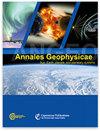对赤道电离异常峰附近午夜前后热大气层重力波和相关化石损耗复苏的同步 OI 630 nm 成像观测
IF 1.9
4区 地球科学
Q3 ASTRONOMY & ASTROPHYSICS
引用次数: 0
摘要
摘要我们报告了午夜前后化石等离子体耗竭的 F 区域气辉成像,这些等离子体耗竭在持续的热大气层重力波(GW)活动下重新恢复。2012 年 4 月 16 日,在印度兰契(北纬 23.3°,东经 85.3°;纬度∼北纬 19°)上空的 OI 630 nm 波段成像中,一台全天空成像仪记录了这些事件。午夜前后出现了向北传播和向东西排列的全球大气环流(λ∼210 km,v∼64 m s-1,τ∼0.91 h)。这种全球大气活动持续了∼2 小时,使两个同时存在并向东漂移的化石损耗区(DP1 和 DP2)恢复了活力。全球变暖驱动的恢复在损耗 DP1 中表现突出,其顶点高度从 ∼600 km 增加到 >800 km,强度损耗水平从 ∼17 % 增加到 50 %。本研究的新颖之处在于,在 OI 630 nm 气辉成像中同时观测热大气层全球变暖活动和相关的损耗演变,以及当地午夜附近的活动,这在以前还没有报道过。目前的理解是,与地磁场线平行并向东传播的全球暖化相位锋更能有效地引发瑞利-泰勒(RT)不稳定性。在这里,全球暖流相锋呈东西走向(即垂直于地磁场线)并向北传播,但它们却恢复了化石损耗。本文章由计算机程序翻译,如有差异,请以英文原文为准。
Simultaneous OI 630 nm imaging observations of thermospheric gravity waves and associated revival of fossil depletions around midnight near the equatorial ionization anomaly (EIA) crest
Abstract. We report F-region airglow imaging of fossil plasma depletions around midnight that revived afresh under persisting thermospheric gravity wave (GW) activity. An all-sky imager recorded these events in OI 630 nm imaging over Ranchi (23.3° N, 85.3° E; mlat. ∼19° N), India, on 16 April 2012. Northward-propagating and east–west-aligned GWs (λ∼210 km, v∼64 m s−1, and τ∼0.91 h) were seen around midnight. Persisting for ∼2 h, this GW activity revived two co-existing and eastward-drifting fossil depletions, DP1 and DP2. GW-driven revival was prominently seen in depletion DP1, wherein its apex height grew from ∼600 to >800 km, and the level of intensity depletion increased from ∼17 % to 50 %. The present study is novel in the sense that simultaneous observations of thermospheric GW activity and the associated evolution of depletion in OI 630 nm airglow imaging, as well as that around local midnight, have not been reported earlier. The current understanding is that GW phase fronts aligned parallel to the geomagnetic field lines and eastward-propagating are more effective in seeding Rayleigh–Taylor (RT) instability. Here, GW fronts were east–west-aligned (i.e., perpendicular to the geomagnetic field lines) and propagated northward, yet they revived fossil depletions.
求助全文
通过发布文献求助,成功后即可免费获取论文全文。
去求助
来源期刊

Annales Geophysicae
地学-地球科学综合
CiteScore
4.30
自引率
0.00%
发文量
42
审稿时长
2 months
期刊介绍:
Annales Geophysicae (ANGEO) is a not-for-profit international multi- and inter-disciplinary scientific open-access journal in the field of solar–terrestrial and planetary sciences. ANGEO publishes original articles and short communications (letters) on research of the Sun–Earth system, including the science of space weather, solar–terrestrial plasma physics, the Earth''s ionosphere and atmosphere, the magnetosphere, and the study of planets and planetary systems, the interaction between the different spheres of a planet, and the interaction across the planetary system. Topics range from space weathering, planetary magnetic field, and planetary interior and surface dynamics to the formation and evolution of planetary systems.
 求助内容:
求助内容: 应助结果提醒方式:
应助结果提醒方式:


